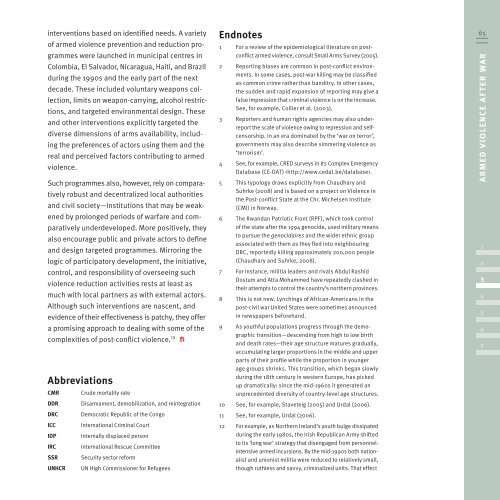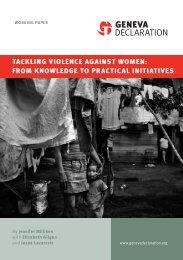Global Burden of Armed Violence - The Geneva Declaration on ...
Global Burden of Armed Violence - The Geneva Declaration on ...
Global Burden of Armed Violence - The Geneva Declaration on ...
Create successful ePaper yourself
Turn your PDF publications into a flip-book with our unique Google optimized e-Paper software.
interventi<strong>on</strong>s based <strong>on</strong> identified needs. A variety<br />
<str<strong>on</strong>g>of</str<strong>on</strong>g> armed violence preventi<strong>on</strong> and reducti<strong>on</strong> pro-<br />
grammes were launched in municipal centres in<br />
Colombia, El Salvador, Nicaragua, Haiti, and Brazil<br />
during the 1990s and the early part <str<strong>on</strong>g>of</str<strong>on</strong>g> the next<br />
decade. <str<strong>on</strong>g>The</str<strong>on</strong>g>se included voluntary weap<strong>on</strong>s col-<br />
lecti<strong>on</strong>, limits <strong>on</strong> weap<strong>on</strong>-carrying, alcohol restric-<br />
ti<strong>on</strong>s, and targeted envir<strong>on</strong>mental design. <str<strong>on</strong>g>The</str<strong>on</strong>g>se<br />
and other interventi<strong>on</strong>s explicitly targeted the<br />
diverse dimensi<strong>on</strong>s <str<strong>on</strong>g>of</str<strong>on</strong>g> arms availability, includ-<br />
ing the preferences <str<strong>on</strong>g>of</str<strong>on</strong>g> actors using them and the<br />
real and perceived factors c<strong>on</strong>tributing to armed<br />
violence.<br />
Such programmes also, however, rely <strong>on</strong> compara-<br />
tively robust and decentralized local authorities<br />
and civil society—instituti<strong>on</strong>s that may be weak-<br />
ened by prol<strong>on</strong>ged periods <str<strong>on</strong>g>of</str<strong>on</strong>g> warfare and com-<br />
paratively underdeveloped. More positively, they<br />
also encourage public and private actors to define<br />
and design targeted programmes. Mirroring the<br />
logic <str<strong>on</strong>g>of</str<strong>on</strong>g> participatory development, the initiative,<br />
c<strong>on</strong>trol, and resp<strong>on</strong>sibility <str<strong>on</strong>g>of</str<strong>on</strong>g> overseeing such<br />
violence reducti<strong>on</strong> activities rests at least as<br />
much with local partners as with external actors.<br />
Although such interventi<strong>on</strong>s are nascent, and<br />
evidence <str<strong>on</strong>g>of</str<strong>on</strong>g> their effectiveness is patchy, they <str<strong>on</strong>g>of</str<strong>on</strong>g>fer<br />
a promising approach to dealing with some <str<strong>on</strong>g>of</str<strong>on</strong>g> the<br />
complexities <str<strong>on</strong>g>of</str<strong>on</strong>g> post-c<strong>on</strong>flict violence. 19<br />
Abbreviati<strong>on</strong>s<br />
CMR Crude mortality rate<br />
DDR Disarmament, demobilizati<strong>on</strong>, and reintegrati<strong>on</strong><br />
DRC Democratic Republic <str<strong>on</strong>g>of</str<strong>on</strong>g> the C<strong>on</strong>go<br />
ICC Internati<strong>on</strong>al Criminal Court<br />
IDP Internally displaced pers<strong>on</strong><br />
IRC Internati<strong>on</strong>al Rescue Committee<br />
SSR Security sector reform<br />
UNHCR UN High Commissi<strong>on</strong>er for Refugees<br />
Endnotes<br />
1 For a review <str<strong>on</strong>g>of</str<strong>on</strong>g> the epidemiological literature <strong>on</strong> postc<strong>on</strong>flict<br />
armed violence, c<strong>on</strong>sult Small Arms Survey (2005).<br />
2 Reporting biases are comm<strong>on</strong> in post-c<strong>on</strong>flict envir<strong>on</strong>ments.<br />
In some cases, post-war killing may be classified<br />
as comm<strong>on</strong> crime rather than banditry. In other cases,<br />
the sudden and rapid expansi<strong>on</strong> <str<strong>on</strong>g>of</str<strong>on</strong>g> reporting may give a<br />
false impressi<strong>on</strong> that criminal violence is <strong>on</strong> the increase.<br />
See, for example, Collier et al. (2003).<br />
3 Reporters and human rights agencies may also underreport<br />
the scale <str<strong>on</strong>g>of</str<strong>on</strong>g> violence owing to repressi<strong>on</strong> and selfcensorship.<br />
In an era dominated by the ‘war <strong>on</strong> terror’,<br />
governments may also describe simmering violence as<br />
‘terrorism’.<br />
4 See, for example, CRED surveys in its Complex Emergency<br />
Database (CE-DAT) .<br />
5 This typology draws explicitly from Chaudhary and<br />
Suhrke (2008) and is based <strong>on</strong> a project <strong>on</strong> <str<strong>on</strong>g>Violence</str<strong>on</strong>g> in<br />
the Post-c<strong>on</strong>flict State at the Chr. Michelsen Institute<br />
(CMI) in Norway.<br />
6 <str<strong>on</strong>g>The</str<strong>on</strong>g> Rwandan Patriotic Fr<strong>on</strong>t (RPF), which took c<strong>on</strong>trol<br />
<str<strong>on</strong>g>of</str<strong>on</strong>g> the state after the 1994 genocide, used military means<br />
to pursue the genocidaires and the wider ethnic group<br />
associated with them as they fled into neighbouring<br />
DRC, reportedly killing approximately 200,000 people<br />
(Chaudhary and Suhrke, 2008).<br />
7 For instance, militia leaders and rivals Abdul Rashid<br />
Dostum and Atta Mohammed have repeatedly clashed in<br />
their attempts to c<strong>on</strong>trol the country’s northern provinces.<br />
8 This is not new. Lynchings <str<strong>on</strong>g>of</str<strong>on</strong>g> African-Americans in the<br />
post-civil war United States were sometimes announced<br />
in newspapers beforehand.<br />
9 As youthful populati<strong>on</strong>s progress through the demographic<br />
transiti<strong>on</strong>—descending from high to low birth<br />
and death rates—their age structure matures gradually,<br />
accumulating larger proporti<strong>on</strong>s in the middle and upper<br />
parts <str<strong>on</strong>g>of</str<strong>on</strong>g> their pr<str<strong>on</strong>g>of</str<strong>on</strong>g>ile while the proporti<strong>on</strong> in younger<br />
age groups shrinks. This transiti<strong>on</strong>, which began slowly<br />
during the 18th century in western Europe, has picked<br />
up dramatically: since the mid-1960s it generated an<br />
unprecedented diversity <str<strong>on</strong>g>of</str<strong>on</strong>g> country-level age structures.<br />
10 See, for example, Staveteig (2005) and Urdal (2006).<br />
11 See, for example, Urdal (2006).<br />
12 For example, as Northern Ireland’s youth bulge dissipated<br />
during the early 1980s, the Irish Republican Army shifted<br />
to its ‘l<strong>on</strong>g war’ strategy that disengaged from pers<strong>on</strong>nelintensive<br />
armed incursi<strong>on</strong>s. By the mid-1990s both nati<strong>on</strong>alist<br />
and uni<strong>on</strong>ist militia were reduced to relatively small,<br />
though ruthless and savvy, criminalized units. That effect<br />
65<br />
A R M E D V I O L E N C E A F T E R WA R<br />
1<br />
2<br />
3<br />
4<br />
5<br />
6<br />
7









